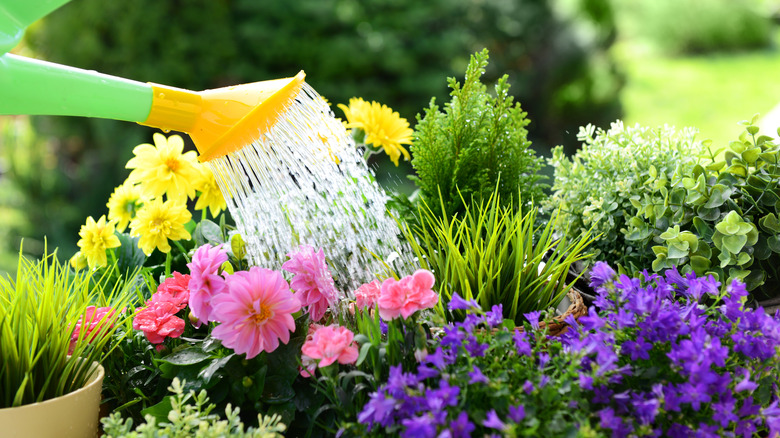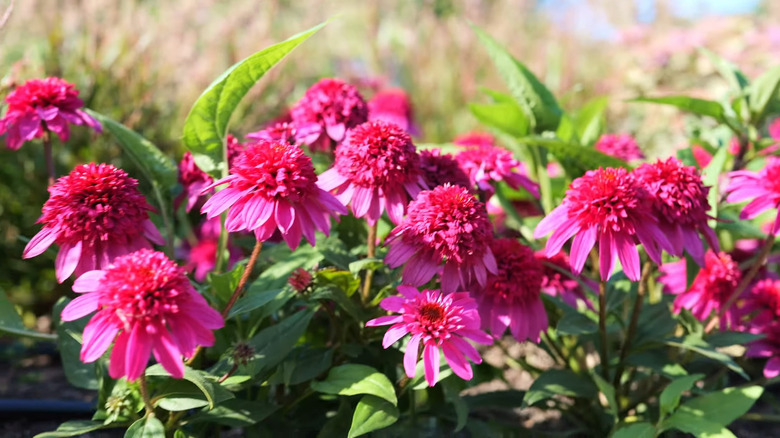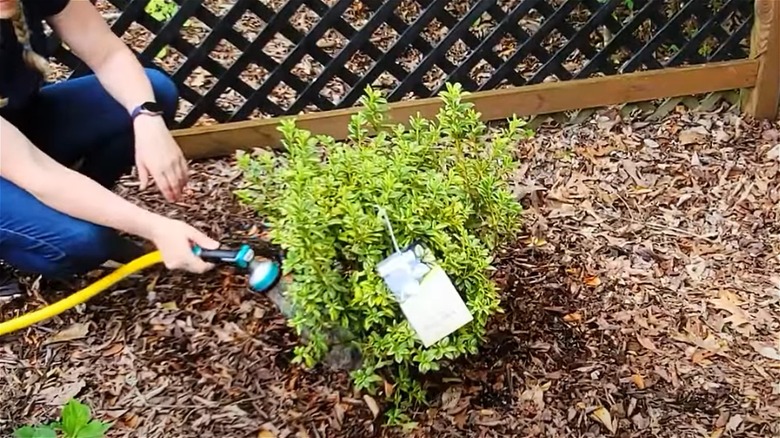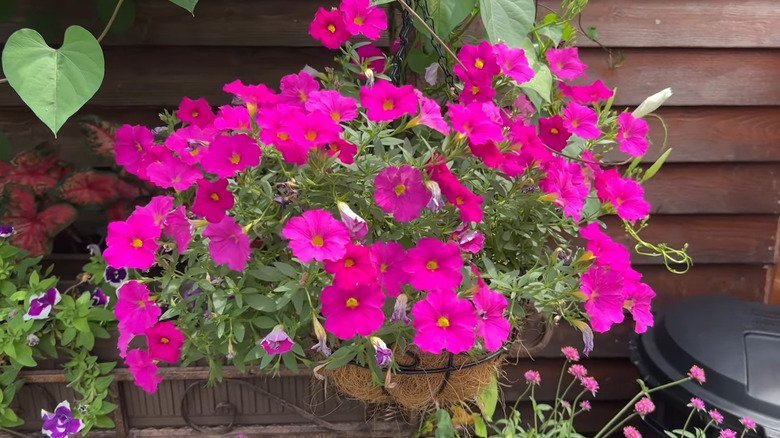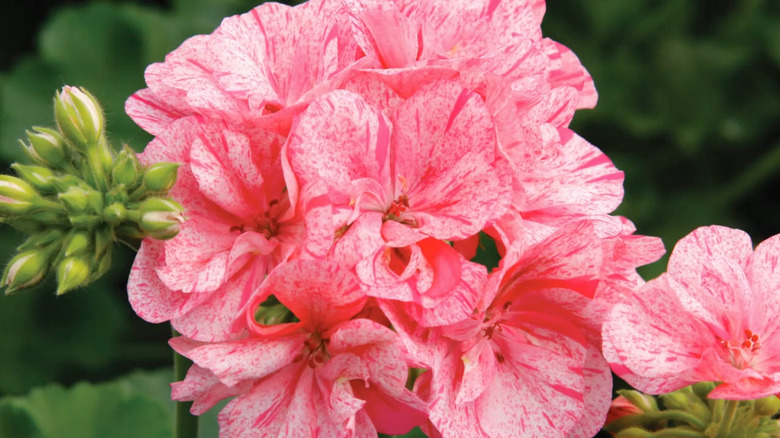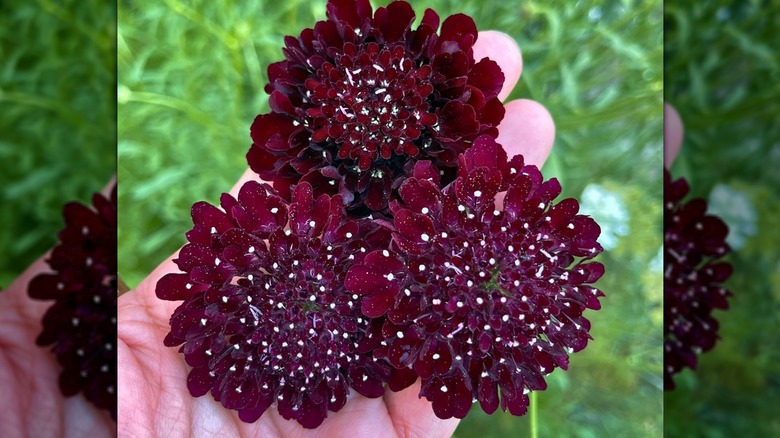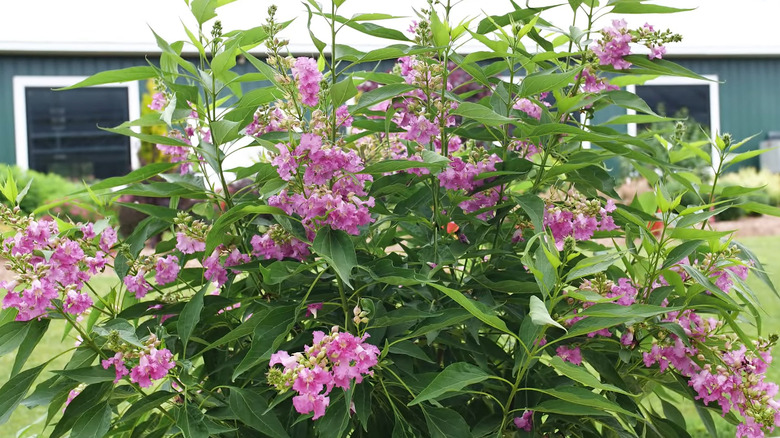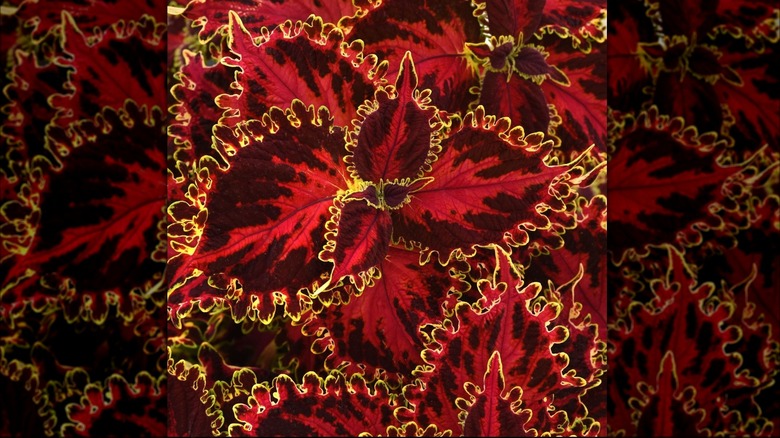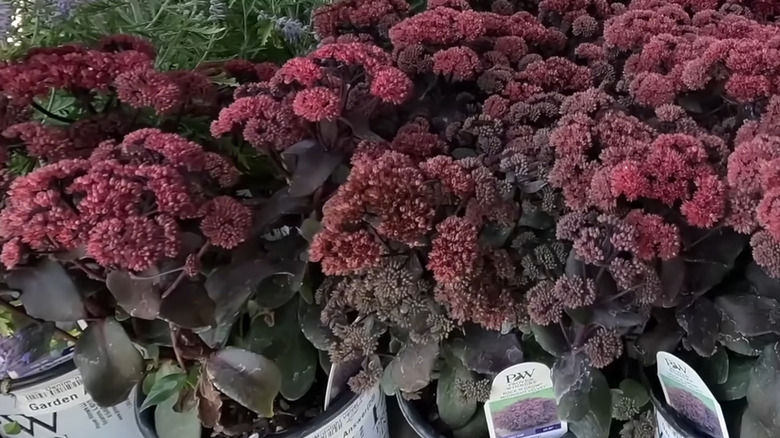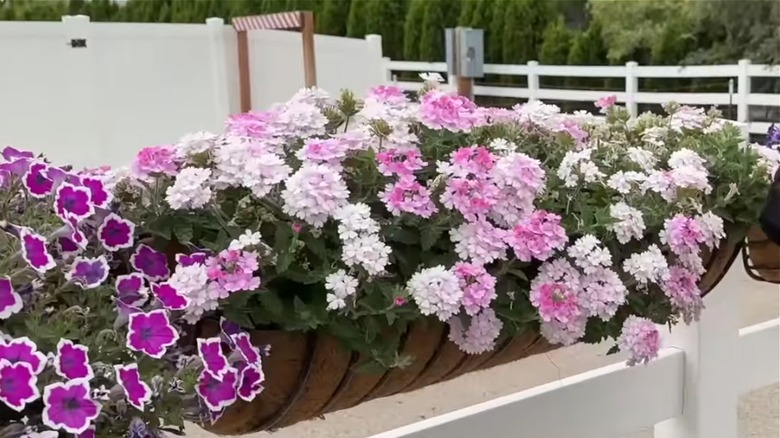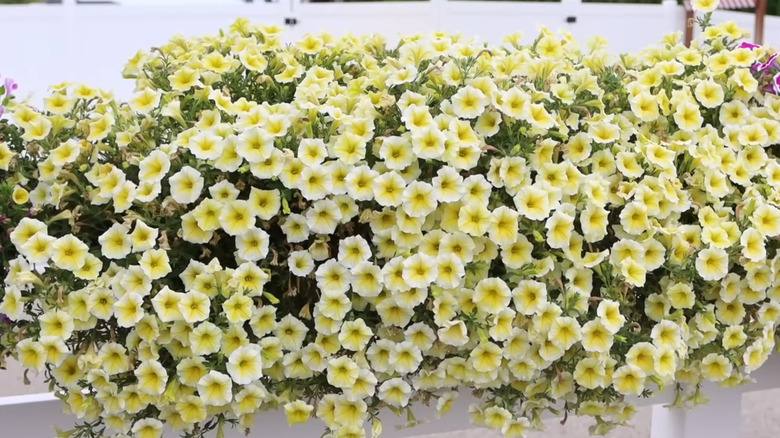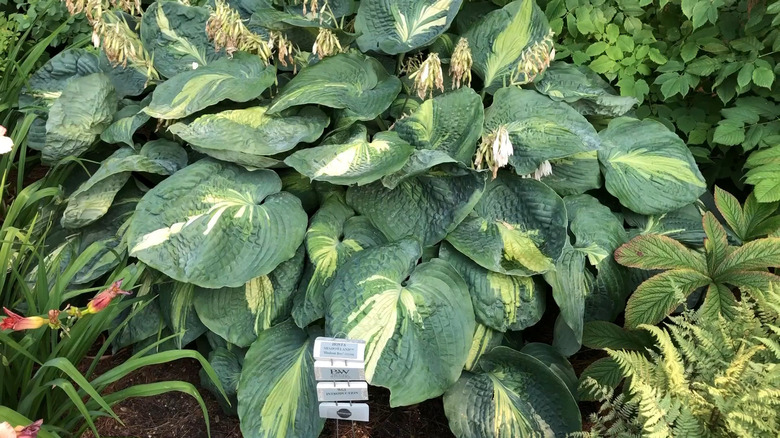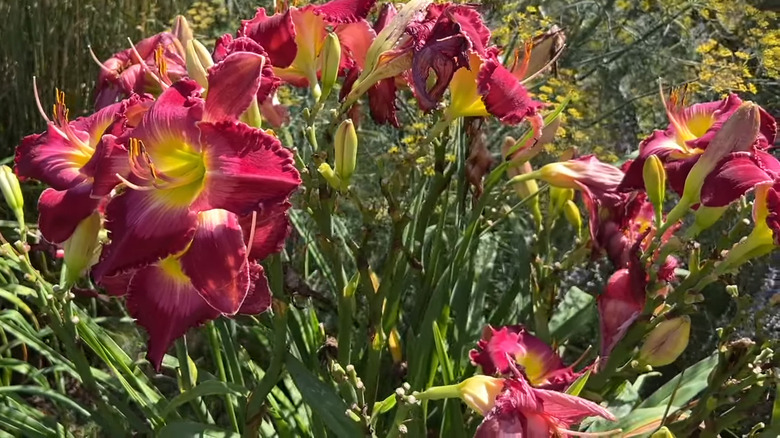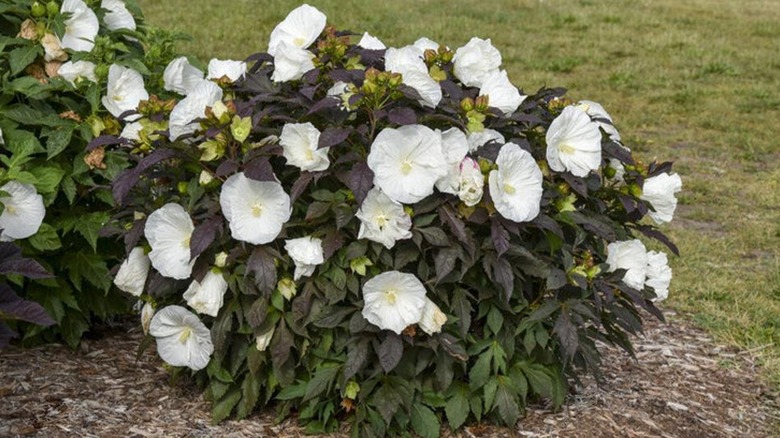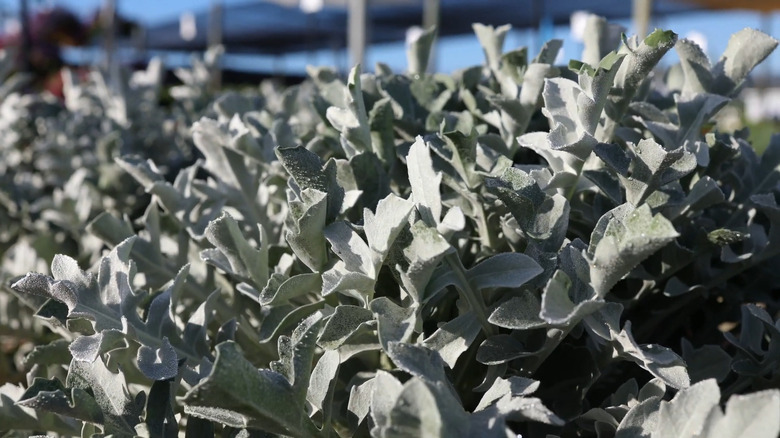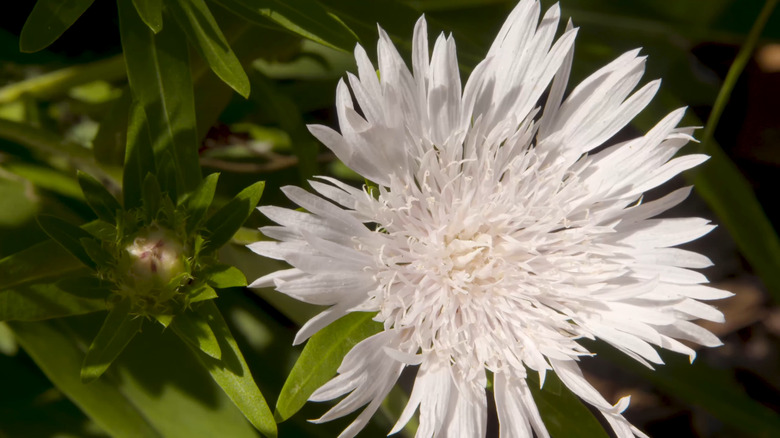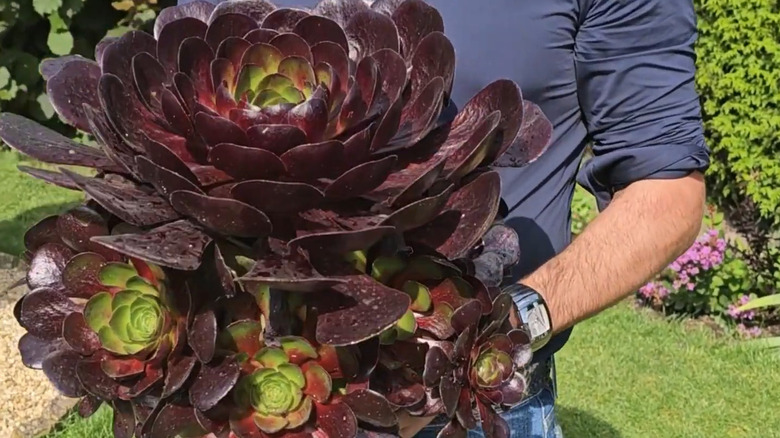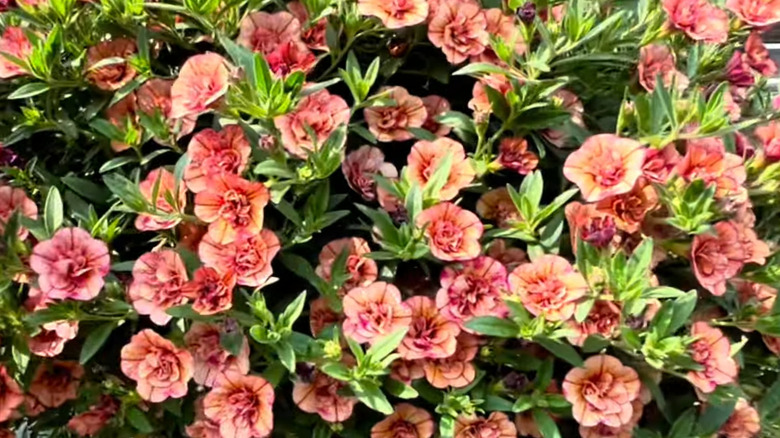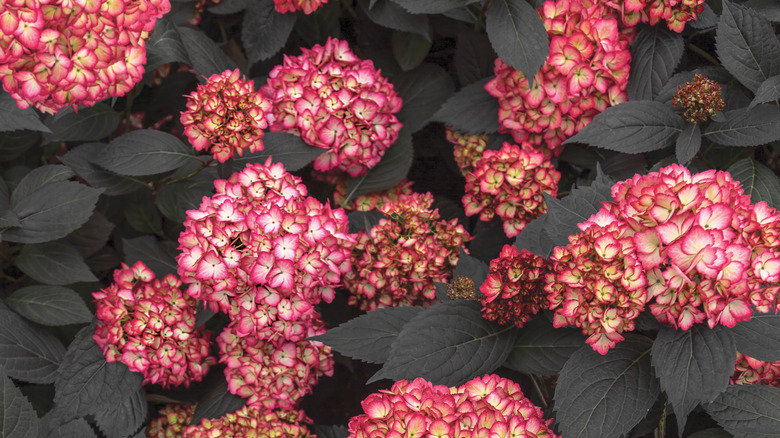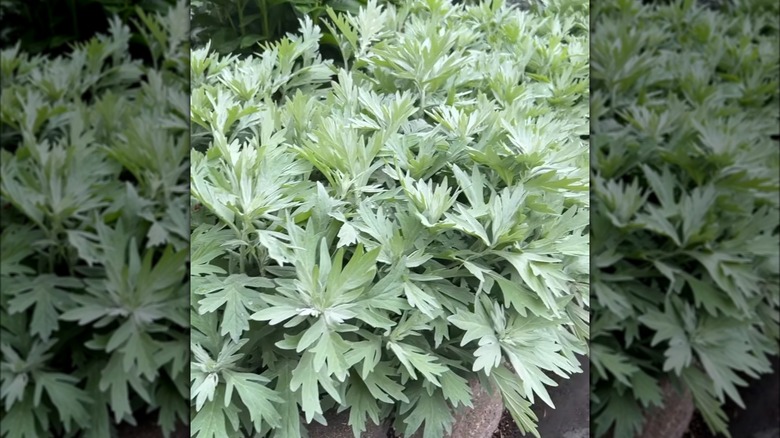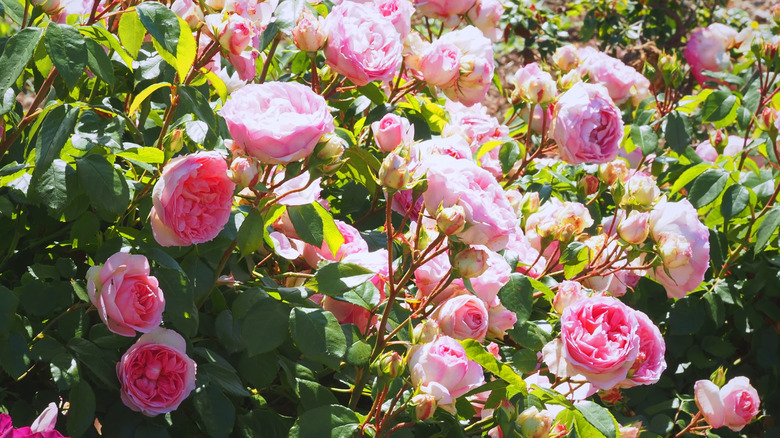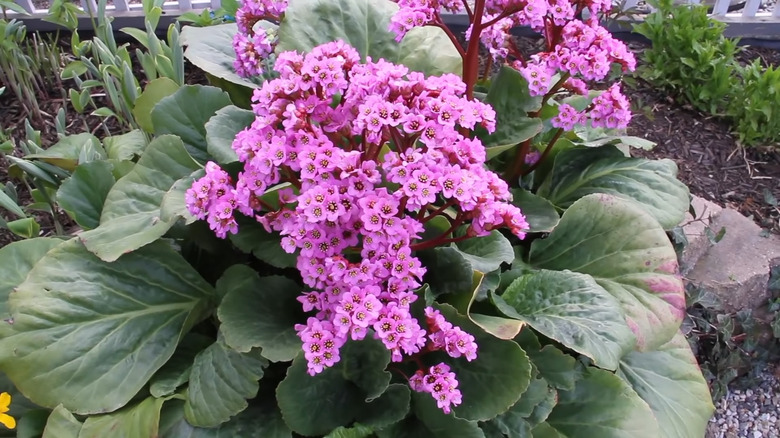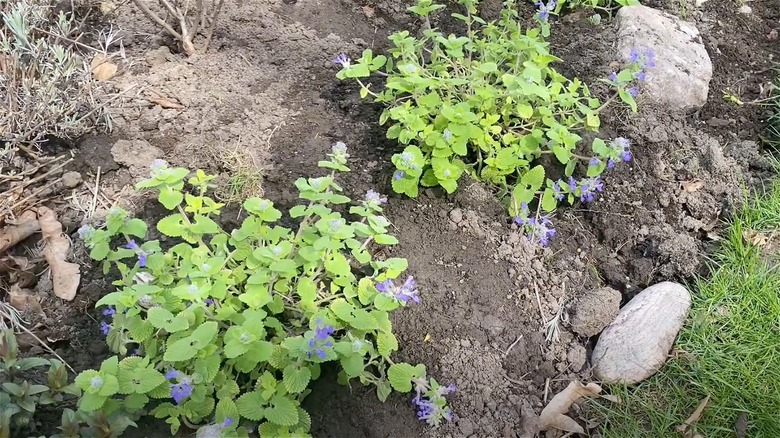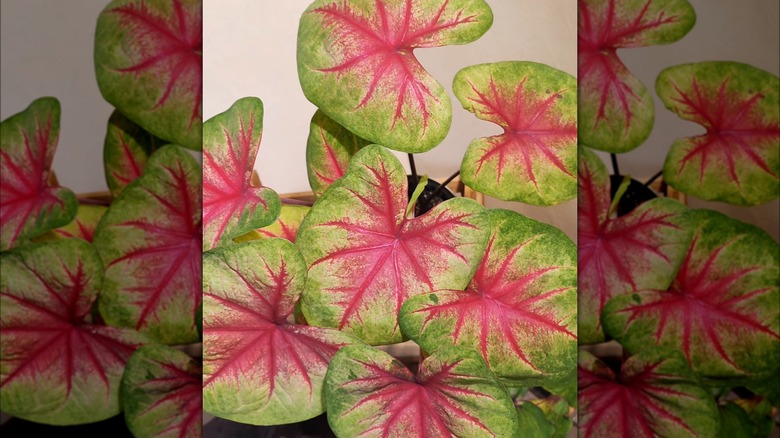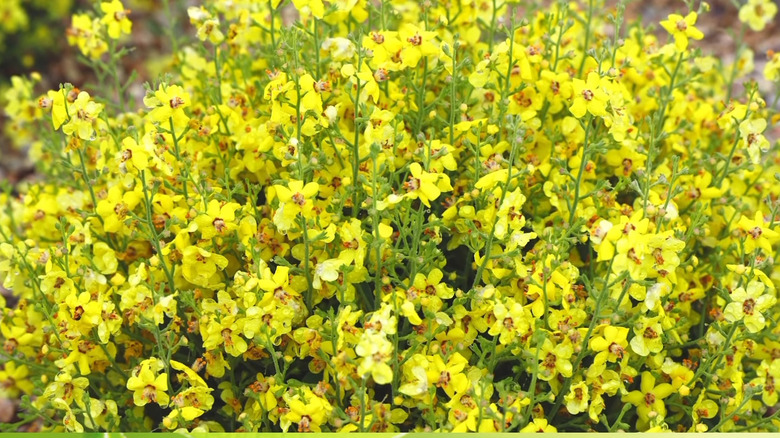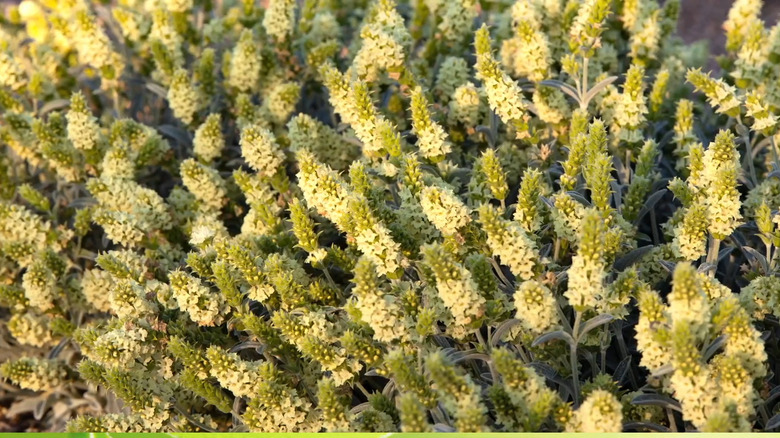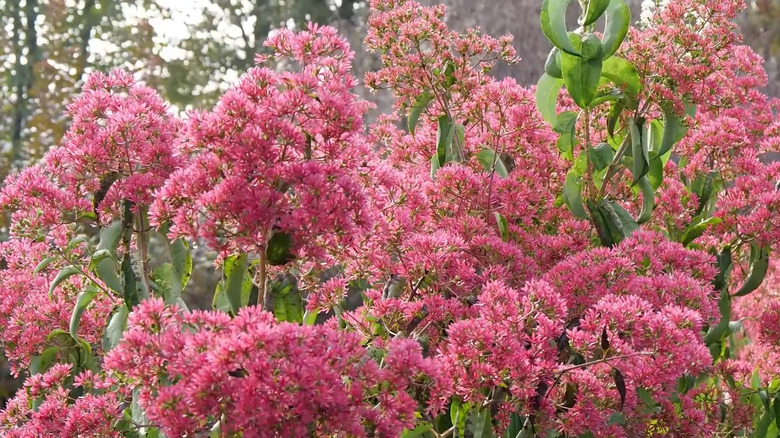26 Stunning New Plants To Add To Your Garden That You Probably Haven't Heard Of
The horticulture industry and home gardeners are always looking for something new, better, or exotic, with the excitement hitting a fever pitch by the time spring waltzes in. This new piece can either be a plant with an improved variety, such as one with a cooler color or pattern variation, an extended flowering season, greater disease resistance, or the creation of different breeds and hybrids. Sometimes, it also encompasses collectibles, rare, or heirloom varieties that otherwise cost a fortune to procure since they aren't sold commercially.
Regardless of how you define new, it stands to say that spring is the best time for adding new plants to your garden to dial up your backyard's pizzazz. Luckily, from award-winning plants like the 'Hudson Bay' hosta, to bizarre-looking types like 'Dark Knight' scabiosa with deep red petals and white dots, we've rounded up 26 of our choosiest favorites in the list below. We've even got a few beauties, including Romantica ball gown rose and 'Eclipse' bigleaf hydrangea, for gardeners who feel at home when surrounded by these garden classics.
1. Double Scoop 'Watermelon Deluxe' coneflower
Renowned for its medicinal benefits and beauty, the Echinacea species has undergone an upgrade to make way for a double-flowered, black-eyed, hot pink cultivar: the Double Scoop 'Watermelon Deluxe' coneflower (Echinacea x hybrida 'Balscmelux'). Despite their relatively-smaller size — 2 feet maximum — these coneflowers exhibit greater flowering and branching, especially in the first planting year. In full sun, their blooms last from spring to summer. Meant for fertile soils of USDA zones 4 to 9, they're great at preventing deer browsing while drawing the attention of birds, bees, and butterflies. Drought tolerance is another plus.
2. 'Autumn Moonstruck' azalea
With its uniquely-stable, gold-variegated, evergreen foliage, 'Autumn Moonstruck' azalea (Rhododendron hybrid 'Roblezf') will leave gardeners in zones 7 to 10 starstruck year-round. To boot, it blooms 2½-inch wide, starch white flowers in spring and keeps reblooming in summer through fall, demonstrating its heaviest display before winter takes over. It grows about 5 feet high and 4 feet wide when planted in well-drained soil, receiving full sun to dappled shade, and becomes drought-tolerant once established. These plants can be used as specimens in borders or containers for an eye-catching spectacle.
3. 'Petchoa EnViva' pink
Benefiting from petunia's heat tolerance without leaving a sticky residue behind or incurring the wrath of budworms, 'Petchoa EnViva' pink (Petunia x Calibrachoa hybrida) is another must-have in floral beds, groundcovers, or container gardens. From spring to fall, it blooms 3-inch wide, yellow-throated, bright-pink flowers that retain their color and sheen through heat, rain, and wind. Growing between 10 and 16 inches tall and spreading 20 to 30 inches across, these annuals require no staking or deadheading. They flourish in full sun and acidic soils with pH ranges of 5.8 to 6.2.
4. Geranium Big EEZE 'Pink Batik'
Dummen Orange, a breeding company, turned around the concept of batiking — the art of producing intricate designs on fabric — on geraniums to produce a mediumly-vigorous 'Pink Batik' cultivar called geranium Big EEZE 'Pink Batik' (Pelargonium x interspecific). Its buds and the semi-double, variegated flowers showcase striking mosaic pink hues with even darker pink speckles atop a green, semi-upright mound from spring until the first frost. Cold hardy in zones 9 to 11, these sun-loving geraniums exhibit stellar heat, drought, and humidity tolerance. They can grow over 1 foot tall by maturity but are toxic to pets.
5. Heirloom scabiosa 'Dark Knight'
Although tracing its origin to the 1600s, the scabiosa cottage plant is deemed new because Renee's Garden (a seed company) is reintroducing its heirloom cultivar, 'Dark Knight' (Scabiosa atropurpurea). Supporting densely-frilled, burgundy-black, pincushion-resembling blooms on an about 3-foot frame, 'Dark Knight' is the best plant for your pollinator garden since it pulls in skipper and monarch butterflies. Requiring full sun, 'Dark Knight' flowers through spring and summer until the frost hits and can be overwintered for a second flush in USDA zone 10 or warmer. Its slender, white stems require staking in the garden but enjoy a functional advantage when cut for bouquets.
6. 'El Niño' desert orchid
Created by hybridizing two native trees, desert willow (Chilopsis) and cigar tree (Catalpa), for their fragrance and hardiness, Chitalpa plants are exquisite, beginner-friendly shrubs for southern gardens in zones 6 to 9. Their 'El Niño' cultivar (Chitalpa 'NCXC1') develops orchid-resembling, papery pink-purplish flowers, with a few shades of yellows sporadically interspersed, attracting bees while resisting deer. Their delightful vanilla-melon fragrance envelops sunny to partly-shaded spots, making them stand out as specimens, especially in dry soils. They mature to heights of 8 feet, making them suitable as privacy walls or hedges, but keep them 5 feet away from buildings.
7. 'Solar Flare' coleus
If you want to add more texture and bright color to your flowering annuals, 'Solar Flare' coleus (Solenostemon scutellarioides 'UF20-103-6') may be just the contrast you need. Cold hardy to 32 degrees Fahrenheit, the dramatically red scalloped foliage with golden margins is a shade-tolerant stunner. However, its red tones become brighter as the sun intensifies. At maturity, this coleus cultivar gains almost 3 feet in height and spans 2½ feet across. It produces unspectacular blue blooms around late spring, but they're best pinched to keep the summer annual bushy. You might have to keep an eye out for whiteflies as well.
8. Rock 'N Grow 'Midnight Velvet' stonecrop
Proven Winner's 'Midnight Velvet' (Sedum hybrid) is the right fit for gardeners meaning to touch up their landscaping without adding to the maintenance. These plants have mauve buds that explode into saturated red flowers, sitting beautifully against regally-purple foliage from summer through fall. Poor soil quality is no problem when growing this beautiful plant in USDA zones 3 to 9, as they require no fertilization or supplemental irrigation. Plus, they're salt-, drought-, heat-, and rabbit-resistant while playing hosts for bees and butterflies. Grow in full sun to watch them reach 2 feet high at maturity and put out winter interest.
9. Superbena 'Pink Cashmere'
If your Barbie-core bug stays strong, the award-winning cultivar 'Pink Cashmere' (Verbena) may be to your liking. With soft, pastel pink-white-hued blooms, superbenas look breathtaking on the ground and in containers, given their mounding growth habit. They enjoy a long blooming season without necessitating deadheading or suffering from powdery mildew, budworms, or deer action. Their massive blooms rival the likes of whiteout superbena and bring more pollinators into your yard and garden when given at least 4 hours of direct sunlight. They're hardy in zones 8 to 11 and grow up to a foot tall.
10. Supertunia 'Saffron Finch'
With large, cheerful-yellow flowers that brighten up any landscape, supertunia 'Saffron Finch' plants (Petunia hybrid) are another worthy addition in USDA zones 10 to 11. They're hardcore spring bloomers that continue flowering until the hard frost with no deadheading required. They merely reach 12 inches high but are twice as wide, making them suitable for placing in front of taller perennials — even better if they're colored red or purple, as the juxtaposition looks exquisite. They can endure full sun, but their flowers will appear a creamy yellow. Hummingbirds, bees, and butterflies flock to these heat-tolerant annuals.
11. Shadowland 'Hudson Bay'
'Hudson Bay' (Hosta hybrid) is another award-winning hosta cultivar set to take over the shaded gardens of zones 3 to 9 when given acidic soil. This variegated plant develops apple-green foliage with creamy-white markings flowing out of its center toward vivid blue leafy edges. Slightly-purple blooms sit atop the plant in summer, calling in the attention of hummingbirds while the large leaves keep them safe from slugs. These native perennials mature to 2 feet tall and thrive in part to full shade.
12. 'Blood, Sweat, and Tears' daylily
Named to honor the labor and love of its creator Karol Emmerich, 'Blood, Sweat, and Tears' daylily (Hemerocallis) is a 28-inch-high perennial producing 6-inch wide, white-edged, aromatic raspberry red blooms. Their vibrant reds are marked by broad, flushed pink eyes that taper into a yellow throat, attracting hummingbirds and other beneficial pollinators. Winter hardy in zones 3 to 9, this vigorous plant tolerates salt, urban pollution, black walnut trees, and poor soils. They put on a second flower flush without requiring deadheading. Although they don't have high watering requirements, they expect full sun.
13. Summerific 'Cookies and Cream' rose mallow
Walters Gardens' recent spin on hibiscus plants has brought forth an alluring day and night combination of white flowers that perch gracefully along the stems on almost-black matte foliage. Lovers of full sun, these natives tolerate partial shade, but the leaves will lose their saturation slightly. Unlike their brethren, 'Cookies and Cream' (Hibiscus hybrid) are compact, reaching 3 feet in height and growing white-eyed late-blooming flowers with pink-tipped undersides, making them perfect for small bog gardens. They thrive in acidic soils (pH levels from 5.5 to 6.2) in zones 4 to 9 and are hummingbird-, bee-, and butterfly-friendly but resist deer.
14. 'Silver Swirl' snowflake dusty miller
Keeping to their name, 'Silver Swirl' snowflake dusty miller (Centaurea ragusina 'Balcentsirl') perennials produce elegant, silvery-white leaves that curl at their ends and look electrifying when fronting the garden border. The under 11 inches tall textural, ruffled mounds bloom during the spring in zones 6 to 9 and spread out to about 14 inches wide. They prefer dry soils and lots of sun. The low irrigation and fertilization requirements make them low-maintenance. As a bonus, rabbits find their foliage unappetizing.
15. Totally Stoked 'Whitecaps' stoke's aster
Popularly grown in southern gardens, stoke's aster is an American native wildflower, and its newly-launched cultivar 'Whitecaps' (Stokesia laevis) is a deer- and rabbit-resistant plant suitable in USDA zones 5 through 9. When deadheaded, it sets a long blooming season of almost 3-inch wide, pink-tinged, gorgeous white flowers that entertain a host of butterflies and bees. These perennials grow 24 to 26 inches high and 32 to 36 inches wide, working great as accent pieces against late bloomers like pink or yellow mums. Plant them in acidic soils and full sun for the best blooms.
16. Surreal 'Destiny' Semponium
In a ground-breaking experiment, Daniel Michael, a British breeder, crossbred hens-and-chicks (Sempervivum) with Aeonium to create Semponium, a cold-hardy succulent that's perfect for waterwise gardening. Monrovia has introduced cultivars like 'Destiny' (Sempervivum x Aeonium), which features green-eyed, dark-burgundy rosettes that retain their dramatic look throughout the year. After two to three years, it dies after producing a flush of yellow flowers and offsets that can be propagated for new plants. It grows 18 inches tall and 24 inches across in full sun to partial shade in zones 8 to 11. As a bonus, deer dislike 'Destiny' Semponiums.
17. Superbells 'Double Vintage Coral'
Those craving a vintage touch for their gardens will find the pollinator-friendly 'Double Vintage Coral' (Double Calibrachoa) plant a good match. Winter hardy in USDA zones 9 to 11, the annual requires full sun for its color-changing petals and veins to assume purple tones rather than sticking to the amber-orange shades. However, it survives in partial shade, provided it receives 4 hours of direct light. Superbells abhor wet feet, so they're best planted in a well-draining soil medium for raised beds to avoid rot. These reach heights of 12 inches while spreading twice as wide and continue to bloom until the first frost.
18. First Editions 'Eclipse' bigleaf hydrangea
As the first-ever dark-leafed macrophylla that retains its deep purplish-black foliage throughout the season, 'Eclipse' bigleaf hydrangea (Hydrangea macrophylla) is a keeper in zones 5 to 9. Depending on the pH of your soil, it will grow gorgeous lavender or cranberry flowers that turn papery brown come winter. It stands 3 to 5 feet tall and just as wide, attracts pollinators, and is resistant to leaf spot and powdery mildew. While it grows in part-shade and prefers some shade during afternoons in warmer climates, it must receive at least 3 hours of direct sun for the best display.
19. Artemisia 'Silver Lining'
Unlike its counterparts, 'Silver Lining' (Artemisia) behaves like a non-invasive perennial due to its mixed parentage. It's a hybrid of two native species, the Western U.S. artemisia and Alaskan artemisia. Staying 16 inches tall and 36 inches wide, it lends the garden a moving texture and a color break with its scallop-edged, frilly, silvery foliage and non-showy yellow inflorescence. Use it as a groundcover or an edge plant in dry soils and in zones 4 to 9. Plant in full sun and benefit from its critter resistance.
20. Romantica ball gown 'Meipapey'
If roses are what you gravitate towards no matter what, Meilland's ball gown 'Meipapey' cultivar (Rosa) will pique your interest thanks to its classic look, fresh aroma, and outstanding disease resistance. Its buds open up to showcase over 100 lush, medium-pink petals, emitting the classic powdery rose fragrance mixed in with grass. The highly-fragrant, upright, hybrid tea rose plant stands 6 feet tall and half as wide in zones 6 to 11. Give it full sun to enjoy vigorous growth and blooms.
21. 'Peppermint Patty' pigsqueak
At home in zones 4 to 8, the 'Peppermint Patty' pigsqueak cultivar (Bergenia hybrid) blooms 1¼ inch wide, white/pink flowers atop wavy, rosy pink stems that transition to lush greens towards the base. The pink picotee flowers have light pink shades radiating out their throat down to their edges that bees and butterflies find alluring. These salt-, deer-, and rabbit-resistant evergreen perennials provide visual interest throughout the year when grown in partial shade to full sun (cold climates). They despise heavy, water-logged soils. Maturing at 22 inches, they work as groundcover and edge plants and bloom in spring.
22. 'Chartreuse on the Loose' catmint
This new catmint cultivar (Nepeta hybrid) earned the National Garden Bureau's perennial award for its bright, chartreuse leaves, which aren't usually found in nepeta plants. The relatively-longer summer blooming season is also a plus, as it continues to bloom pretty clusters of powdery blue to violet flowers, no shearing required. Site in sunny yards of zones 3 to 8 with good drainage to watch the cat magnets grow up to a foot tall in borders. Although its fragrance will attract your pet cats, deer and rabbits will steer clear of your garden, allowing pollinators to frolic about in peace.
23. Heart To Heart 'Lemon blush'
For those bereaved by shade and deer, the 'Lemon Blush' (Caladium) presents a solution. This annual brightens the darkest garden areas with its variegated chartreuse lemony-green leaves and rosy pinks that flow out of the center and in the veins. The heat-tolerant plant can also be overwintered in zones 10 and 11 for a second comeback. The foliage-forward plant matures to 14 inches across and 20 inches high when planted in warm, well-draining soils. Mass plant them or use them as companions to hostas for greater visual appeal.
24. 'Letitia' flannel plant
Unlike the yellow-spiked, wooly mullein plants you commonly find along the roadside or in abandoned industrial sites, the 'Letitia' flannel plant (Verbascum 'Letitia') is a well-behaved perennial since it's sterile due to its mixed parentage. Moreover, instead of developing racemes, it produces typical purple or red-eyed yellow flowers that pollinators love to perch on. Its 1-foot tall and wide grayish-green mound adds to the garden's manicured look, albeit appearing slightly unruly during the winter. But it tolerates part-shade and exhibits drought tolerance, making it perfect for border planting in waterwise landscapes of zones 5 to 10.
25. Sarada's Greek mountain tea
If you're tired of your lamb's ear getting afflicted with leaf rot right after a rain spell, Sarada's Greek mountain tea (Sideritis syriaca 'P023S') is a worthy groundcover replacement in zones 5 to 9. The relatively-healthier and hardier evergreen perennial, also called ironwort, grows similarly-soft, silverish-green foliage that later gets covered in whorls of small, slightly-yellowed blooms in summer. As a bonus, deer and rabbits ignore its foliage, with the plants retaining their 12-inch, compact mound without colonizing any extra space. Grow in full sun in waterwise landscapes and harvest to create the famous Greek tea.
26. Temple of Bloom seven-son flower
A collector's mainstay, the seven-son flower (Heptacodium miconioides) continues to build its presence in garden centers, partly due to its four-season interest and attraction to pollinators. The 20-foot-tall beauty grows deeply-veined, deep green leaves during the spring, which later get adorned by aromatic, dainty white flowers around whom hummingbirds and bees love to gather. The blooms die down during the fall to make space for garish red bracts (sepals) and are eventually shed in winter along with the leaves, drawing the eye toward the tree's lightly-peeling coffee bark. Grow in full to part sun in zones 5 to 9.
